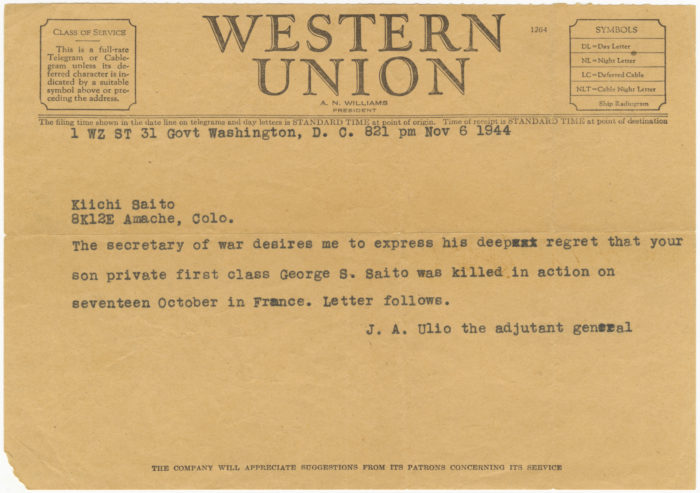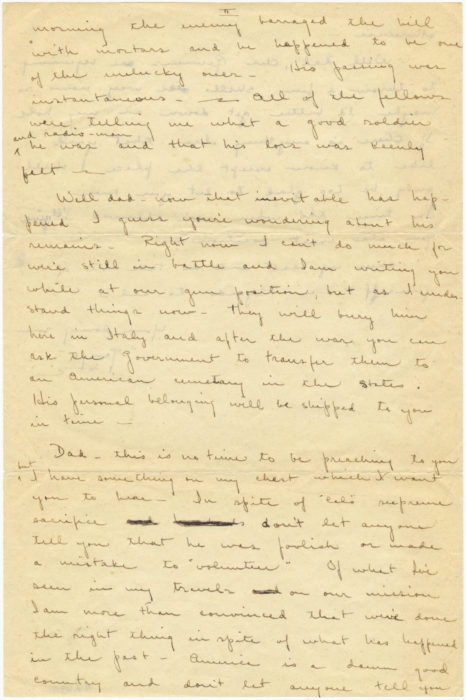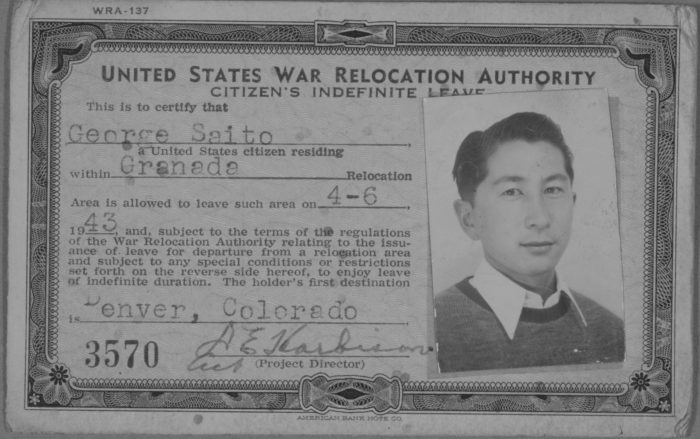Telegram to a Father

Japanese American National Museum, Gift of Mary Saito Tominaga (94.49.33)
Click to open full-size image in new tab.Read this document closely.
This is a telegram to Kiichi Saito. Three of Mr. Saito’s sons served in the United States Army during World War II including his son George, who is referenced in this telegram.
- Where was Mr. Saito living at the time he received this telegram?
- How would you describe the tone of this message?
- What questions do you have after reading this document?
Mary Saito Tominaga and Kazuo Saito video interview (November 2, 2010), Japanese American National Museum
Click to open full-size image in new tab.
Watch this video of George Saito’s brother Kazuo and sister, Mary.
- Based on what they say about him in this clip, why do you think George decided to join the army?
- What can you gather about George from this clip? What type of person was he?
- Where was the Saito family living when George left to join the army?
- Did you notice the photograph of George and his brothers Calvin and Shozo? How are they all dressed in the photograph?

Japanese American National Museum, Gift of Mary Saito Tominaga (94.49.41)
Click to open full-size image in new tab.In 1944, while attacking a hill in Italy, George’s younger brother Calvin, who was also serving in the army, was struck and killed. This is from a letter George sent home to console his grief-stricken father.
Dad—this is no time to be preaching to you but I have something on my chest which I want you to hear In spite of Cal’s supreme sacrifice, don’t let anyone tell you that he was foolish or made a mistake to “volunteer.” Of what I’ve seen in my travels, on our mission, I am more than convinced that we’ve done the right thing in spite of what has happened in the past. America is a damn good country and don’t let anyone tell you otherwise.
– George Saito, letter to his father, July 11, 1944
- What do you think is the main message George has for his father?
- If you were in George’s position, do you think you would share his sentiments? Why or why not?
- Why do you think George felt it necessary to write these words?

Japanese American National Museum, Gift of Mary Saito Tominaga (94.6.77)
Click to open full-size image in new tab.- Does this document give any clue as to who George Saito is?
- Does he look like a young man or an older man?
- What country is he a citizen of?
- What might prompt a government to monitor its citizens in this way?
- At the time this document was issued, where was George residing?
- Does such a document make you question the rights and limitations of an American citizen?
This document is George’s indefinite leave card, issued by the government as a way to monitor any subversive behavior in its American-born citizens of Japanese ancestry. This card gave George permission to leave Amache concentration camp. Soon after its issuance, George enlisted in the United States Army and served in the segregated 442nd RCT in Europe.

Japanese American National Museum, Gift of Mary Saito Tominaga (94.49.33)
Click to open full-size image in new tab.In 1942, the United States government forced the Saito family to leave their home in Los Angeles, California, where George had a produce market. They were sent to Granada concentration camp, also known as Amache. (One brother, Kazuo, was sent to Heart Mountain because he lived in a different part of Los Angeles than the rest of his family.)
Amache is where the Saito family was living when 25-year-old George volunteered for the segregated 442nd Regimental Combat Team. George hoped that his service would free his family from unjust imprisonment. Together with his younger brothers Shozo and Calvin, George was sent to Europe, where he fought as a loyal American who strongly believed in his country. This sentiment of loyalty was shared by many young Japanese Americans who fought for their country despite its great violation of their civil rights.
Return to Loyalty
